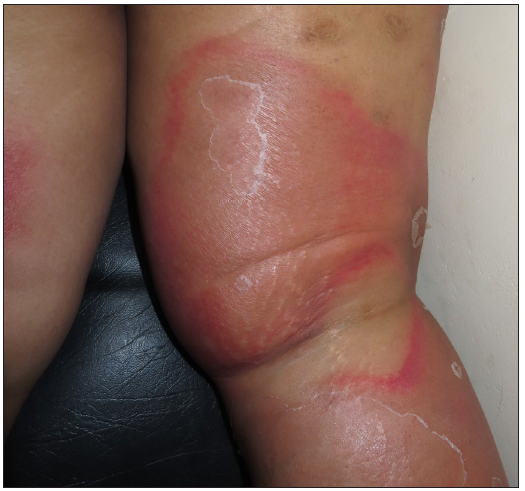Erysipeloid is a bacterial skin infection caused by Erysipelothrix rhusiopathiae, a gram-positive rod-shaped bacterium commonly found in animals and the environment. It primarily affects individuals handling fish, meat, and animal products, making it an occupational disease prevalent among butchers, fishermen, veterinarians, and farmers. This zoonotic infection presents mainly as a localized skin lesion but can occasionally lead to systemic complications.

Causes and Risk Factors
Erysipeloid occurs through direct contact with contaminated animal products or infected surfaces. The primary risk factors include:
- Handling raw fish, poultry, or meat
- Occupational exposure in slaughterhouses, fisheries, and farms
- Existing skin abrasions, cuts, or puncture wounds
- Contact with infected animals
Types of Erysipeloid and Symptoms
Erysipeloid manifests in three main forms:
1. Cutaneous Erysipeloid (Localized Form)
- Red-purple lesions with well-defined borders
- Mild pain, swelling, and warmth at the infection site
- Self-limiting, usually resolving within 2–3 weeks
2. Diffuse Cutaneous Erysipeloid
- Widespread skin lesions
- Moderate fever and malaise
- Occurs due to bacterial spread but remains superficial
3. Systemic Erysipeloid (Septicemic Form)
- Rare but severe form
- Symptoms include high fever, chills, joint pain, and endocarditis
- Requires urgent medical intervention
Diagnosis of Erysipeloid
Accurate diagnosis is crucial for effective management. Diagnostic methods include:
- Clinical Examination: Evaluating characteristic skin lesions and occupational history
- Bacterial Culture: Isolating Erysipelothrix rhusiopathiae from skin lesions or blood samples
- Polymerase Chain Reaction (PCR): Identifying bacterial DNA for confirmation
- Histopathology: Rarely used but may assist in complex cases
Treatment and Management
Erysipeloid treatment depends on its severity:
- Localized Erysipeloid:
- First-line treatment: Penicillin or amoxicillin
- Alternative antibiotics: Cephalosporins, erythromycin, or fluoroquinolones for penicillin-allergic patients
- Symptomatic relief: Analgesics and anti-inflammatory drugs
- Systemic Erysipeloid:
- Intravenous penicillin for severe infections
- Hospitalization in cases of endocarditis or widespread bacteremia
- Monitoring for complications such as sepsis or arthritis
Prevention and Control Measures
Preventing erysipeloid involves occupational safety and hygiene practices:
- Wearing protective gloves and clothing when handling animal products
- Maintaining strict hygiene protocols in workplaces
- Proper wound care and immediate antiseptic application on cuts
- Avoiding direct contact with infected animals
Complications of Erysipeloid
Although usually mild, erysipeloid can lead to severe complications:
- Endocarditis: Life-threatening heart valve infection
- Septicemia: Blood infection requiring urgent care
- Arthritis: Joint inflammation in prolonged cases

